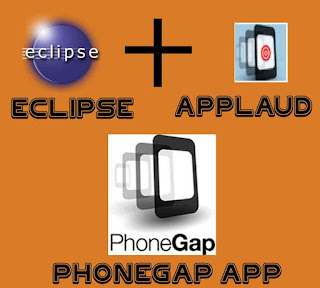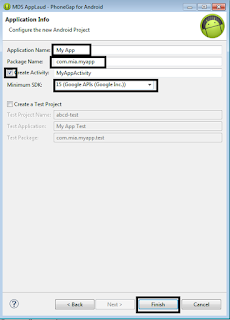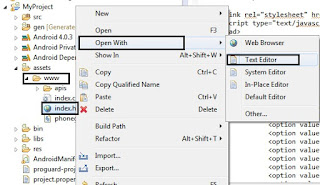We will learn to navigate to a new page by clicking on list item. I will consider a Custom List from the one of the
previous post.
What we will do?
-> We will make a list with some items. When we click on a list-item we will traverse to a specific page.
What we will need?
- activity_jaguar.xml (newly added)
- MainActivity.java (changes required)
- Jaguar.java (newly added)
- AndroidManifest.xml (changes required)
Note : we will edit the project from one of the
previous post of Custom List.
Step 1 : Add a android xml file in res->layout folder and name it as
activity_jaguar.xml. Right Click on layout->New->Android XML Layout.
activity_jaguar.xml
<?xml version="1.0" encoding="utf-8"?>
<LinearLayout xmlns:android="http://schemas.android.com/apk/res/android"
android:layout_width="match_parent"
android:layout_height="match_parent"
android:orientation="vertical" >
<TextView
android:id="@+id/textView1"
android:layout_width="wrap_content"
android:layout_height="wrap_content"
android:text="Jaguar's business was founded as the Swallow Sidecar Company in 1922, originally making motorcycle sidecars before developing bodies for passenger cars." />
</LinearLayout>
Step 2 : Add a class under
src->com.mia.customlistdemo folder by name it as
Jaguar.java. Right Click on com.mia.customlistdemo under src->New->Class
Jaguar.java
package com.mia.customlistdemo;
import android.app.Activity;
import android.os.Bundle;
public class Jaguar extends Activity{
public void onCreate(Bundle savedInstanceState) {
super.onCreate(savedInstanceState);
setContentView(R.layout.activity_jaguar);
}
}
The
Project Skeleton is shown as below:
Step 3 : Go to
MainActivity.java from the
previous post. Remove the toast at the end lines and replace it with
Intents. Right now I will connect only the second list item(
Jaguar) with one page (
Jaguar.java), the other list items will return a toast as before.
The modified MainActivity.java is shown below
package com.mia.customlistdemo;
import java.util.ArrayList;
import java.util.HashMap;
import android.app.ListActivity;
import android.content.Context;
import android.content.Intent;
import android.os.Bundle;
import android.text.Editable;
import android.text.TextWatcher;
import android.view.LayoutInflater;
import android.view.View;
import android.view.ViewGroup;
import android.widget.ArrayAdapter;
import android.widget.EditText;
import android.widget.ImageView;
import android.widget.ListView;
import android.widget.TextView;
import android.widget.Toast;
public class MainActivity extends ListActivity {
//ArrayList thats going to hold the search results
ArrayList<HashMap<String, Object>> searchResults;
//ArrayList that will hold the original Data
ArrayList<HashMap<String, Object>> originalValues;
LayoutInflater inflater;
@Override
public void onCreate(Bundle savedInstanceState) {
super.onCreate(savedInstanceState);
setContentView(R.layout.activity_main);
final EditText searchBox=(EditText) findViewById(R.id.searchBox);
ListView playersListView=(ListView) findViewById(android.R.id.list);
//get the LayoutInflater for inflating the customomView
//this will be used in the custom adapter
inflater=(LayoutInflater) getSystemService(Context.LAYOUT_INFLATER_SERVICE);
//these arrays are just the data that
//I'll be using to populate the ArrayList
//You can use our own methods to get the data
String names[]={"FIESTA","XJ","BOXSTER"};
String teams[]={"Ford","Jaguar","Porsche"};
Integer[] photos={R.drawable.picford,R.drawable.picjaguar,R.drawable.picporsche};
originalValues=new ArrayList<HashMap<String,Object>>();
//temporary HashMap for populating the
//Items in the ListView
HashMap<String , Object> temp;
//total number of rows in the ListView
int noOfPlayers=names.length;
//now populate the ArrayList players
for(int i=0;i<noOfPlayers;i++)
{
temp=new HashMap<String, Object>();
temp.put("name", names[i]);
temp.put("team", teams[i]);
temp.put("photo", photos[i]);
//add the row to the ArrayList
originalValues.add(temp);
}
//searchResults=OriginalValues initially
searchResults=new ArrayList<HashMap<String,Object>>(originalValues);
//create the adapter
//first param-the context
//second param-the id of the layout file
//you will be using to fill a row
//third param-the set of values that
//will populate the ListView
final CustomAdapter adapter=new CustomAdapter(this, R.layout.activity_item,searchResults);
//finally,set the adapter to the default ListView
playersListView.setAdapter(adapter);
searchBox.addTextChangedListener(new TextWatcher() {
public void onTextChanged(CharSequence s, int start, int before, int count) {
//get the text in the EditText
String searchString=searchBox.getText().toString();
int textLength=searchString.length();
searchResults.clear();
for(int i=0;i<originalValues.size();i++)
{
String playerName=originalValues.get(i).get("name").toString();
if(textLength<=playerName.length()){
//compare the String in EditText with Names in the ArrayList
if(searchString.equalsIgnoreCase(playerName.substring(0,textLength)))
searchResults.add(originalValues.get(i));
}}
adapter.notifyDataSetChanged();
}
public void beforeTextChanged(CharSequence s, int start, int count,
int after) {}
public void afterTextChanged(Editable s) {}
});
}
//define your custom adapter
private class CustomAdapter extends ArrayAdapter<HashMap<String, Object>>
{
public CustomAdapter(Context context, int textViewResourceId,
ArrayList<HashMap<String, Object>> Strings) {
//let android do the initializing :)
super(context, textViewResourceId, Strings);
}
//class for caching the views in a row
private class ViewHolder
{
ImageView photo;
TextView name,team;
}
ViewHolder viewHolder;
@Override
public View getView(int position, View convertView, ViewGroup parent) {
if(convertView==null)
{
convertView=inflater.inflate(R.layout.activity_item, null);
viewHolder=new ViewHolder();
//cache the views
viewHolder.photo=(ImageView) convertView.findViewById(R.id.photo);
viewHolder.name=(TextView) convertView.findViewById(R.id.name);
viewHolder.team=(TextView) convertView.findViewById(R.id.team);
//link the cached views to the convertview
convertView.setTag(viewHolder);
}
else
viewHolder=(ViewHolder) convertView.getTag();
int photoId=(Integer) searchResults.get(position).get("photo");
//set the data to be displayed
viewHolder.photo.setImageDrawable(getResources().getDrawable(photoId));
viewHolder.name.setText(searchResults.get(position).get("name").toString());
viewHolder.team.setText(searchResults.get(position).get("team").toString());
//return the view to be displayed
return convertView;
}
}
protected void onListItemClick(ListView l, View v, int position, long id) {
// TODO Auto-generated method stub
super.onListItemClick(l, v, position, id);
String str = searchResults.get(position).get("name").toString();
try{
if(str=="XJ"){
Class jClass = Class.forName("com.mia.customlistdemo.Jaguar");
Intent jIntent = new Intent(this, jClass);
startActivity(jIntent);
}
if(str=="FIESTA"){
Toast.makeText(getApplicationContext(), "FIESTA\nFORD", Toast.LENGTH_SHORT).show();
}
if(str=="BOXSTER"){
Toast.makeText(getApplicationContext(), "BOXSTER\nPORSCHE", Toast.LENGTH_SHORT).show();
}
}
catch(Exception e){
e.printStackTrace();
}
}
}
MainActivity.java










































